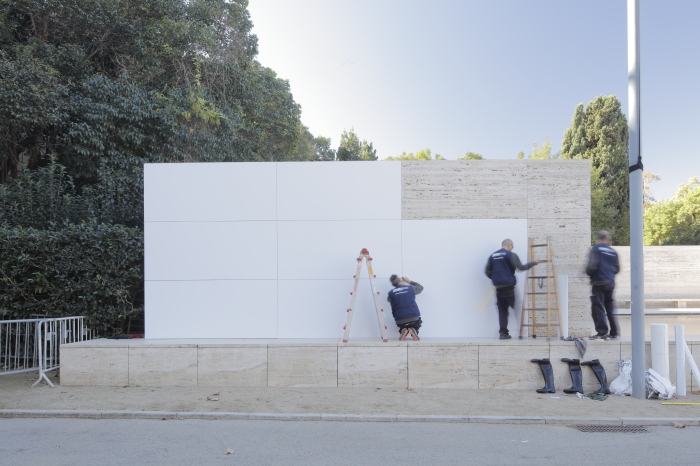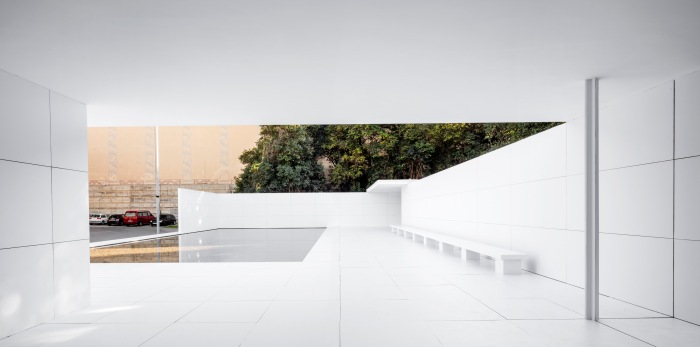It has been a while… I know. After a few months of silence and PhD work, I am back on track with ‘a new season of articles’ on archithoughts’ blog. I will try to be more consistent and curate my writing in a way that it transmits a critical message to the reader. I hope you enjoy this new season on archithoughts and follow all my articles and reflections on cities, culture and urban interventions.
To start with, I would like to talk about the new intervention done by the Catalan architects Anna and Eugeni Bach, who were immersed in transforming the Mies van der Rohe Pavilion, located in Barcelona, with their project “mies missing materiality”.
Fundació Mies van der Rohe (Barcelona) periodically invites artists and architects to provoke new perspectives through their interventions in the Pavilion, enhancing it as a space of inspiration and experimentation for the most innovative artistic and architectural production. And this year was the turn of the architects Anna and Eugeni Bach following previous interventions done by SANAA, Jeff Wall, Ai Wei Wei, Enric Miralles, Andrés Jaque, Antoni Muntadas and others.

According to the information facilitated by Mies press, their project turns the Pavilion into a mock-up, with all the surfaces clad with the same white material that shows the representative role of both the original work and its reconstruction. For 11 days, starting on November 8th, the Pavilion turned into a 1:1 scale model of the longest-standing temporary pavilion in modern architecture. The Mies Pavilion began to lose its materiality and gradually turned into a mock-up through an assembly performance involving the placement of white vinyl. Currently, it is possible to appreciate the building completely in white. It will on 27 November when the pavilion will restore its materiality that belongs to it.
According to the authors:
“To provide the Pavilion in Barcelona with that homogenising whiteness means to endow it with one of the defining features of modern historiography (not of modernity). Yet at the same time, it also involves stripping the Pavilion of its materiality and its unique characteristics specifically the one that erected it as an icon of the modern movement.
The installation turns this paradox into an experience. It helps visitors to consider these ideas and many more through their own experience in a pavilion that will lose all trace of its materiality for a few days to assume all its representative potential”.

This simple act turns the Pavilion into a representation of itself that opens the door to multiple interpretations about aspects like the value of the original, the role of the white surface as an image of modernity and the importance of materiality in the perception of space.
The Mies pavilion that should have been temporary was immortalised first by the written account of the modern movement and later by its own reconstruction.
Turning the Pavilion into a mock-up, with all the surfaces restricted to the same material, as white as it is indeterminate, reveals the building’s representative role—both that of the original, as a national symbol, and that of the replica, by representing the former. For a time, the Pavilion will be the longest-standing 1:1 scale mock-up of the replica of the temporary pavilion in modern architecture.
Removing all materiality from the Pavilion also raises other interpretations related to the historiography of 20th-century architecture.
The Pavilion in Barcelona was enthroned as an icon of modernity at the ‘Modern Architecture’ exhibition at the MoMA in New York in 1932. The exhibition catalogue presents various buildings by architects like Mies van der Rohe, Le Corbusier, Neutra, Wright, Oud, Gropius and others through a selection of photographs and critical essays in which Philip Johnson and Henry-Russell Hitchcock indicate the homogenising criteria for combining all the works through the same lens. These include the white surface as an emblem of a new architecture, which appears as one of the most insistent.
To provide the Pavilion in Barcelona with that homogenising whiteness means to endow it with one of the defining features of modern historiography (not of modernity). Yet at the same time, it also involves stripping the Pavilion of its materiality and its unique characteristics—specifically the one that erected it as an icon of the modern movement.
The installation turns this paradox into an experience. It helps visitors to consider these ideas and many more through their own experience in a pavilion that will lose all trace of its materiality for a few days to assume all its representative potential.

And, if it happens you are in Barcelona and want to follow up this (de) and (re) materialisation process:
- 8 to 15 November: Dematerialisation
- 16 to 27 November: Dematerialised pavilion
- 27 to 28 November: Rematerialisation
- November 16 at 13:30h: There will be a conversation between Anna and Eugeni Bach, and María Langarita and Carlos Quintáns, emanating from Juhani Pallasmaa’s reflexions.
All images are courtesy of ©Adrià Goulà
